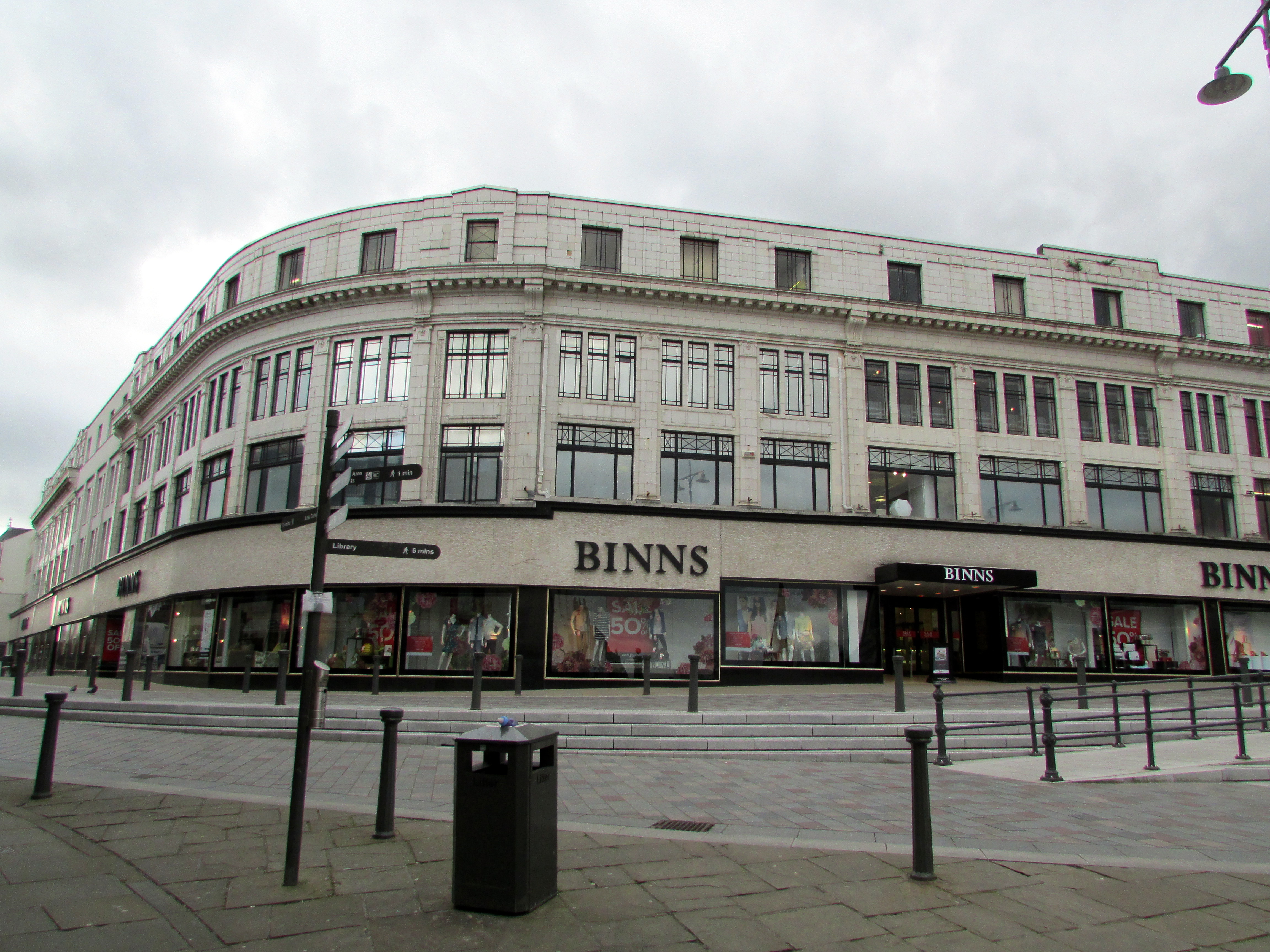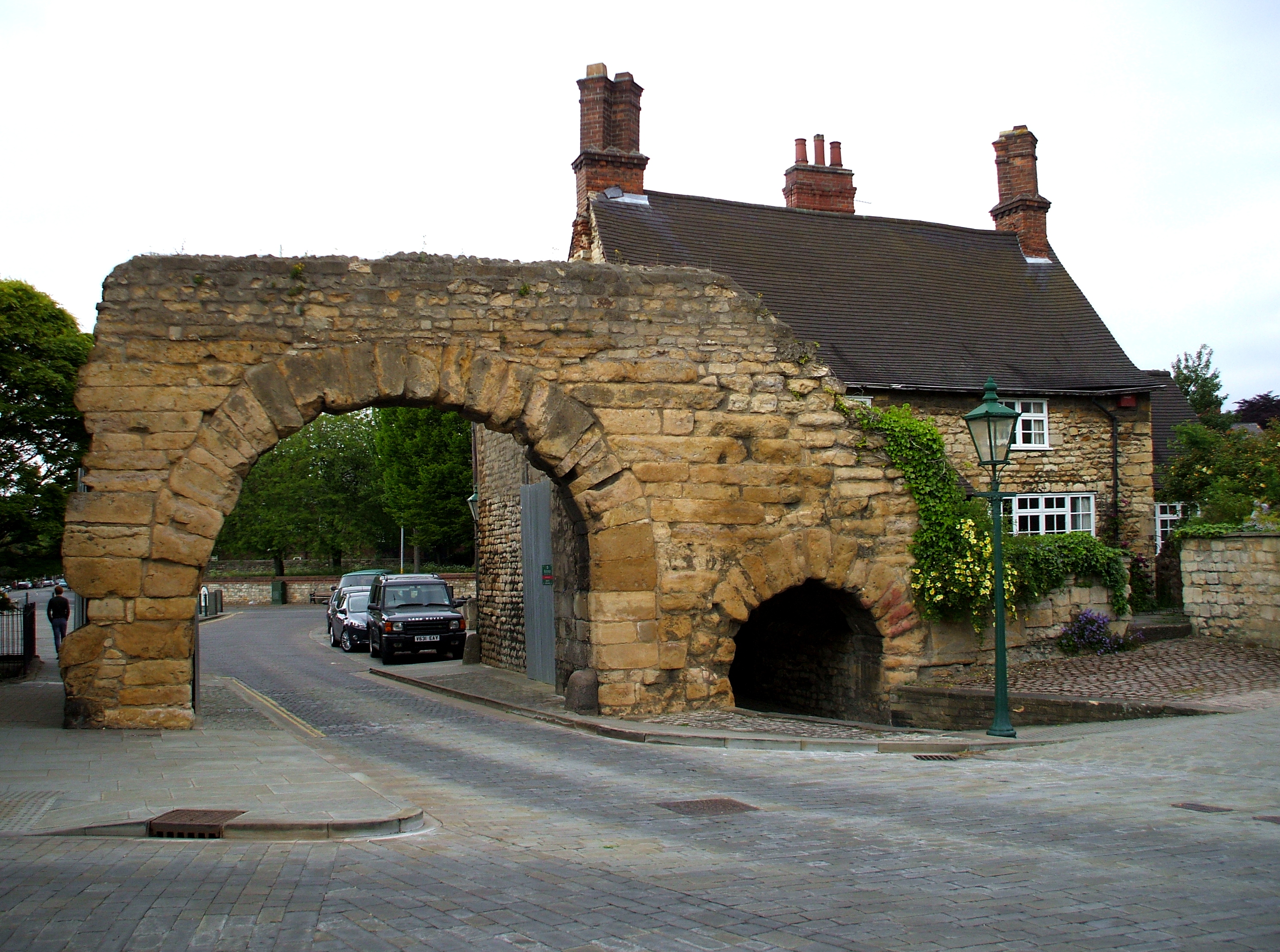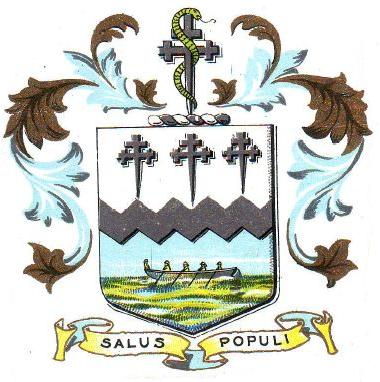|
Binns (department Store)
H. Binns, Son & Co. was a chain of department stores based in Sunderland, Tyne and Wear, Sunderland, later purchased and absorbed by House of Fraser. Early history George Binns moved to Sunderland from Yorkshire in 1804, establishing a small drapery business in 1807 before taking over a larger wool and linen drapery store owned by Thomas Ellerby. Binns was assisted by his son Henry in the store at 176 High Street, Bishopwearmouth, Sunderland. In 1836 Henry inherited the store on the death of his father and began trading under the name Henry Binns. He was a member of the anti-slavery movement and sold only cotton grown by free labour. By 1844 the shop had moved from 176 to 173 High Street. In 1865 Henry retired and his son Joseph John Binns took control of the business changing its name to H. Binns, Son & Co. By 1884 the business had moved again, renting two houses at 38-39 Fawcett Street where the house frontages were replaced with a new shop front and the interior remodelled. ... [...More Info...] [...Related Items...] OR: [Wikipedia] [Google] [Baidu] |
Binns
Binns may refer to: * Binns (surname), English surname * Binns (department store), British retailer * Binns Hall, Virginia, United States * House of the Binns, historic estate near Linlithgow, Scotland {{disambig ... [...More Info...] [...Related Items...] OR: [Wikipedia] [Google] [Baidu] |
Guy & Smith
Guy & Smith was a department store located in Grimsby and is now part of House of Fraser. History Joseph Guy opened a drapery store in October 1850 on North St Mary's Gate, which had been home to Mr Snow's drapery business since 1801. By 1871 he had taken on a partner, Joseph Smith and new premises trading as Guy & Smith at 19 Victoria Street, Grimsby. By 1913 the store had been rebuilt and its departments were costume and dress goods, millinery, silks, children's outfitters and furnishings. The business was incorporated in 1920, and continued to expand purchasing neighbouring shops including the business of Lister's China shop and Holder Brothers piano store. The business continued to be an independent company until 1969 when House of Fraser bought the store. The following year the business was renamed Binns Binns may refer to: * Binns (surname), English surname * Binns (department store), British retailer * Binns Hall, Virginia, United States * House of the Binns, historic es ... [...More Info...] [...Related Items...] OR: [Wikipedia] [Google] [Baidu] |
Mawer & Collingham
Mawer & Collingham was a department store located in Lincoln, England until being purchased by House of Fraser in 1980. History William Mawer is listed as trading as a linen draper at 229 High Street in Lincoln in 1810, however it is not known when the business actually started up. William's daughter Elizabeth married Joseph Collingham, and along with William's son, also called William signed a partnership agreement in 1822 which saw the business become Mawer, Son & Co before changing to Mawer & Collingham. The business expanded and in 1826 they purchased 228 High Street to expand the premises. By 1829 Joseph Collingham was the sole proprietor of the business, but by 1873 his son Joseph Mawer Collingham had not only joined the firm but had taken over as sole proprietor. In 1900 the business was incorporated as a private limited company, and was listed as a wholesale and retail drapers, silk mercers, haberdashers, milliners, dressmakers, tailors, hatters, furriers, lacemen, clothi ... [...More Info...] [...Related Items...] OR: [Wikipedia] [Google] [Baidu] |
Lincoln, England
Lincoln () is a cathedral city and non-metropolitan district, district in Lincolnshire, England, of which it is the county town. In the 2021 Census, the city's district had a population of 103,813. The 2021 census gave the Lincoln Urban Area, urban area of Lincoln, including Bracebridge Heath, North Hykeham, South Hykeham and Waddington, Lincolnshire, Waddington, a recorded population of 127,540. Roman Britain, Roman ''Lindum Colonia'' developed from an Iron Age settlement of Celtic Britons, Britons on the River Witham, near the Fosse Way road. Over time its name was shortened to Lincoln, after successive settlements, including by Anglo-Saxons and Danes (tribe), Danes. Landmarks include Lincoln Cathedral (English Gothic architecture; for over 200 years the world's tallest building) and the 11th-century Norman architecture, Norman Lincoln Castle. The city hosts the University of Lincoln, Bishop Grosseteste University, Lincoln City F.C. and Lincoln United F.C. Lincoln is the large ... [...More Info...] [...Related Items...] OR: [Wikipedia] [Google] [Baidu] |
Owen Owen
Owen Owen was a Liverpool-based operator of department stores in the United Kingdom and Canada. Beginning with a drapery shop in Liverpool, a chain of department stores was built up, often by taking over rival retailers. The company remained under Owen / Norman family control until the 1980s, and the brand ceased to be used in 2007. Founder and early history Owen Owen was born on 13 October 1847 at Cwmrhaeadr near Machynlleth at the westernmost tip of Montgomeryshire, Wales.National Library of Wales, Owen Owen, Liverpo ... [...More Info...] [...Related Items...] OR: [Wikipedia] [Google] [Baidu] |
Doncaster
Doncaster ( ) is a city status in the United Kingdom, city in South Yorkshire, England. Named after the River Don, Yorkshire, River Don, it is the administrative centre of the City of Doncaster metropolitan borough, and is the second largest settlement in South Yorkshire after Sheffield. Noted for its Horse racing in Great Britain, racing and History of rail transport in Great Britain , railway history, it is situated in the Don Valley on the western edge of the Humberhead Levels and east of the Pennines. It had a population of 87,455 at the 2021 United Kingdom census, 2021 census, whilst its urban area, built-up area had a population of 160,220, and the wider metropolitan borough had a population of 308,100. Adjacent to Doncaster to its east is the Isle of Axholme in Lincolnshire, which contains the towns of Haxey, Epworth, Lincolnshire, Epworth and Crowle, Lincolnshire, Crowle, and directly south is Harworth Bircotes in Nottinghamshire. Also, within the city's vicinity are Bar ... [...More Info...] [...Related Items...] OR: [Wikipedia] [Google] [Baidu] |
Harrods
Harrods is a Listed building, Grade II listed luxury department store on Brompton Road in Knightsbridge, London, England. It was designed by C. W. Stephens for Charles Digby Harrod, and opened in 1905; it replaced the first store on the grounds founded by his father Charles Henry Harrod in 1849, which burned down in 1881. The store spans of selling space, making it the largest department store in Europe and one of the largest in the world. Harrods is one of the most famous department stores worldwide, attracting 15 million visitors annually . The original holding company, Harrod's Stores Limited, was formed and began trading on the London Stock Exchange in 1889. It was acquired by and merged into the House of Fraser in 1959, which itself was acquired by the Mohamed Al-Fayed, Fayed brothers and became a privately held company in 1985. When the House of Fraser was relisted on the stock exchange, the Harrods business was split off to remain privately held in 1994. The present-day ... [...More Info...] [...Related Items...] OR: [Wikipedia] [Google] [Baidu] |
Liverpool
Liverpool is a port City status in the United Kingdom, city and metropolitan borough in Merseyside, England. It is situated on the eastern side of the River Mersey, Mersey Estuary, near the Irish Sea, north-west of London. With a population of (in ), Liverpool is the administrative, cultural and economic centre of the Liverpool City Region, a combined authority, combined authority area with a population of over 1.5 million. Established as a borough in Lancashire in 1207, Liverpool became significant in the late 17th century when the Port of Liverpool was heavily involved in the Atlantic slave trade. The port also imported cotton for the Textile manufacture during the British Industrial Revolution, Lancashire textile mills, and became a major departure point for English and Irish emigrants to North America. Liverpool rose to global economic importance at the forefront of the Industrial Revolution in the 19th century and was home to the Liverpool and Manchester Railway, firs ... [...More Info...] [...Related Items...] OR: [Wikipedia] [Google] [Baidu] |
Blackpool
Blackpool is a seaside town in Lancashire, England. It is located on the Irish Sea coast of the Fylde peninsula, approximately north of Liverpool and west of Preston, Lancashire, Preston. It is the main settlement in the Borough of Blackpool, borough of the same name. Blackpool was originally a small hamlet; it began to grow in the mid-eighteenth century, when sea bathing for health purposes became fashionable. Blackpool's beach was suitable for this activity, and by 1781 several hotels had been built. The opening of a railway station in 1846 allowed more visitors to reach the resort, which continued to grow for the remainder of the nineteenth century. In 1876, the town became a borough. Blackpool's development was closely tied to the Lancashire cotton mill, cotton-mill practice of annual factory maintenance shutdowns, known as wakes weeks, when many workers chose to visit the seaside. The town saw large growth during the late Victorian and Edwardian periods. By 1951 its popu ... [...More Info...] [...Related Items...] OR: [Wikipedia] [Google] [Baidu] |
Southport
Southport is a seaside resort, seaside town in the Metropolitan Borough of Sefton in Merseyside, England. It lies on the West Lancashire Coastal Plain, West Lancashire coastal plain and the east coast of the Irish Sea, approximately north of Liverpool and southwest of Preston, Lancashire, Preston. At the United Kingdom Census 2021, 2021 census, Southport had a population of 94,421, making it the List of North West England cities and metropolitan areas by population, eleventh most populous settlement in North West England and the third most populous settlement in the Liverpool City Region. The town was founded in 1792 by William Sutton (Southport), William Sutton, an innkeeper from Churchtown, Merseyside, Churchtown, who built a bathing house at what is now the south end of Lord Street, Southport, Lord Street.''North Meols and Southport – a History'', Chapter 9, Peter Aughton (1988) The area was previously known as South Hawes, and was sparsely populated and dominated ... [...More Info...] [...Related Items...] OR: [Wikipedia] [Google] [Baidu] |
Harrogate
Harrogate ( ) is a spa town and civil parish in the North Yorkshire District, district and North Yorkshire, county of North Yorkshire, England. Historic counties of England, Historically in the West Riding of Yorkshire, the town is a tourist destination; its visitor attractions include its spa waters and Harlow Carr, RHS Harlow Carr gardens. Yorkshire Dales National Park and the Nidderdale AONB are away from the town centre. In the 17th century, Harrogate grew out of two smaller settlements, High Harrogate and Low Harrogate. For three consecutive years (2013–2015), polls voted the town as "the happiest place to live" in Britain. Harrogate spa water contains iron, sulphur, and common salt (NaCl). The town became known as 'The English Spa' in the Georgian era, after its waters were discovered in the 16th century. In the 17th and 18th centuries its 'chalybeate' waters (containing iron) were a popular health treatment, and the influx of wealthy but sickly visitors contributed sig ... [...More Info...] [...Related Items...] OR: [Wikipedia] [Google] [Baidu] |
Scunthorpe
Scunthorpe () is an industrial town in Lincolnshire, England, and the county's third most populous settlement after Lincoln, England, Lincoln and Grimsby, with a population of 81,286 in 2021. It is the administrative centre and largest settlement of the North Lincolnshire district. Scunthorpe lies north of Lincoln and is between Grimsby to the east and Doncaster to the west, while Kingston upon Hull, Hull is to the north-east via the Humber Bridge. Etymology The town appears in the Domesday Book of 1086 as , which is from the Old Norse language, Old Norse meaning "Skuma's homestead", a site which is believed to be in the town centre, close to Market Hill. Today Skuma’s homestead means ‘A secondary settlement, a dependent outlying farmstead or hamlet’. History Scunthorpe as a town came into existence due to the exploitation of the local ironstone which began in 1859; iron production commenced in 1864, Scunthorpe Steelworks, steel smelting in 1891. Scunthorpe's populat ... [...More Info...] [...Related Items...] OR: [Wikipedia] [Google] [Baidu] |






